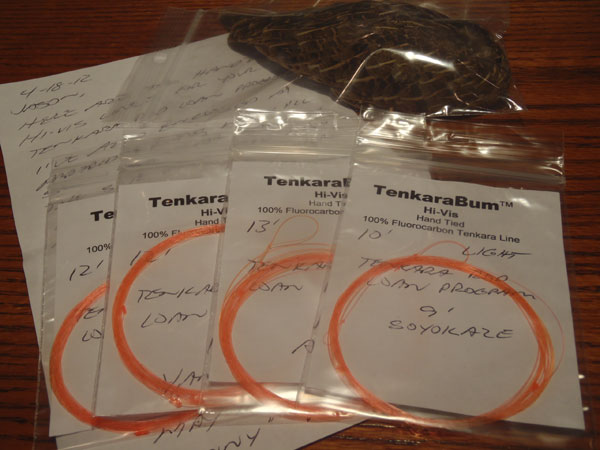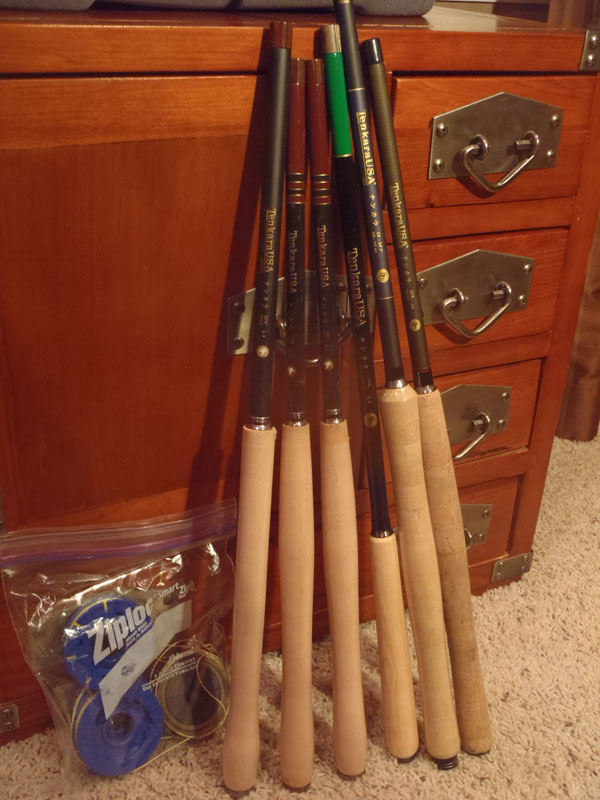Today, I got some good tenkara gear in the mail. But this time, I’m not hoarding it all for myself–it’s for you too! The first was a box of tenkara rods and lines generously donated by Tenkara USA for our tenkara rod loaner program. I’ll be adding these to the demo page this weekend. I’m excited to tell you that in addition to getting a couple more of one of the most popular rods (the Iwana), we’ll now also be able to loan out the premium Tenkara USA rod, the Ito (which happens to be my favorite Tenkara USA rod).Just to update all of you who have requested demo rods, there’s been a slight delay in getting them out because the demand has been overwhelming. But I’ll be getting rods out soon so thank you for your patience.

The other package I got was another generous donation from Chris Stewart at Tenkara Bum for the rod demo program. Among them is a 10 ft. light line for the 9 ft. Daiwa Soyokaze (which he also donated to the program). I’m actually picking up the Soyokaze from Karel tomorrow and will hopefully get a chance to fish and review it before loaning it out.
So what about MY gear? Well, I also got a beautiful partridge wing from Chris. It’s a high quality wing with lots of feathers that will tie sakasa kebari in the #12 – #14 range and I’m really looking forward to tying with it. Chris will have them for sale soon so be sure to keep an eye out in the Tenkara Bum Store for them.









This is great that you are organizing this program Jason. You may be able to get some more rods donated to you by fountainhead if you contact them.
A great gesture from both Daniel (TUSA) and Chris (TenkaraBum), very cool of both to support the program.
Can you tell us the rods names from left to right? I have an Ayu and would like a second rod. I cant decide between an Amago and a Iwana.
I seem to fish for slightly larger fish here in PA, with the average fish being 16″ to 20″.
Suggestions?
Hi George:
I have the rods you are considering, and for bigger fish I’d definitely go with the Amago. Not only longer, but certainly more “backbone” to help with the fish you describe.
The Iwana is a great all-around rod, and can land the larger fish you describe, but I think you’d be happier with the Amago.
Mossy
George, from left to right: Amago, Iwana 12 ft., Iwana 12 ft., Ebisu, Ito, Yamame.
Jason,
What a great program you’ve started; wish I could have tried my Amago before buying it cuz it turns out I much prefer the more relaxed action and lighter weight of my Ebisu, probably making the Ayu more of what I was looking for in a second rod for larger waters.
But my question is about the materials used to construct the Amago vs. Ebisu. The Amago blanks have a matte black finish with substantial ribbing down the lenght of the blank, where as the Ebisu and other rods have a smooth glossy finish. After fishing both rods on about a dozen trips it seems that the ribbed (larger overall diameter) carbon walls of the Amago are thinner and more prone to fracture than the glossy (smaller overall diameter)carbon blanks of the Ebisu. So, Jason, what do you know about the ribbed carbon used on the Amago and the relative carbon-wall strength of the butt sections of the various rods?
Hi Kevin,
Hmmmm….you ask an interesting question. I’m not a tenkara rod designer so someone like Daniel can probably give you a better answer. Everything I’m about to say comes from my understanding of western fly rod design so it may or not be applicable to tenkara rods but here goes. Spirals are sometimes used to increase the strength of blanks. Some designs sand them down, others leave them on–it just depends on the taper, wall thickness, and other properties of the rod. My guess would be that having spirals on sections of a blank that fit together (i.e. a telescopic rod) would actually prevent wear from loosening the fit of the sections. In fact, some tenkara rods like Daiwa use grooves where the sections fit together so that if they wear, it will still be a snug fit with no “clicking”. Again, this is an educated guess based on my western background. I still haven’t broken a tenkara rod (tip, butt, or otherwise) so I’m not at all concerned about wall strength of the butt sections. I’m actually more concerned about the sections fitting snugly after wear. But again, I haven’t had any tenkara rods wear out yet so that might be an unfounded concern. I would love to have someone with deeper knowledge of rod construction weigh in. My knowledge of rod building is mostly based on the techniques Orvis used since I used to work with them.